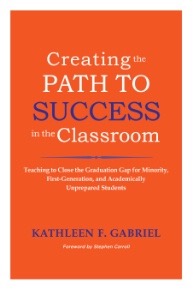integration
Select an item by clicking its checkbox
ePortfolios are web-based, student-generated collections of their work and reflections on their learning and growth. They are tools for students to synthesize and integrate their learning, inside and outside of the classroom, by critically reflecting on their academic and co-curricular experiences. I first learned about ePortfolios from George Kuh who ...

Creating the Path to Success in the Classroom: Teaching to Close the Graduation Gap for Minority, First-Generation, and Academically Unprepared Students
Date Reviewed: October 8, 2018
Kathleen Gabriel’s Creating the Path to Success in the Classroom is a clear, engaging, and practical book that will be of use to anyone teaching in a university or community-college classroom.
In his forward to the book, Stephen Caroll praises Gabriel’s “deep integration of theory and practice” (xiii). This integration is one of the book’s major strengths. Gabriel introduces the reader to scholarship on barriers to student learning, student mindsets, and effective pedagogy. Extensively referenced and cited, Gabriel’s book is thus a primer on classic and more recent scholarship of teaching and learning. After describing this scholarship, Gabriel then offers practical suggestions of classroom strategies designed to engage students effectively given the data. These range from one-time strategies – reading a particular article on growth mindsets as a class, doing an active-learning activity – to strategies that unfold over the course of an entire semester. Gabriel offers concrete scripts for welcoming students and setting a classroom tone, giving student feedback that encourages persistence and growth, creating and shuffling small groups, and much more. Gabriel not only suggests what to do and why, but also encourages faculty to make those reasons explicit to students, making students intentional partners in their own learning.
Gabriel explores strategies for creating a positive classroom climate during the first days of class, engaging students during the first month of the semester, growth mindsets and mental toughness, creating interactive lectures, motivating students to read, think about, and discuss course readings, integrating critical thinking and writing into class activities and assignments, and developing student resilience and persistence. In four appendices, Gabriel offers even more practical suggestions. For example, in her chapter on classroom climate, Gabriel notes that “one way that professors can increase their own cultural competence is to read both nonfiction and fiction material that addresses multicultural issues” (20). Gabriel then directs the reader to Appendix A, a list of nonfiction and fiction readings by authors of color that helped her expand her own “cultural competence and awareness” (131).
Gabriel is gentle in encouraging faculty to teach minority, first-generation, and academically unprepared students more effectively, suggesting incremental steps that faculty can take as they become more comfortable with new pedagogical strategies. She insists throughout that inclusive pedagogy not come at the expense of a rigorous academic standards: “We can design our assignments in a way that holds students to high standards, but, at the same time, we can give all our students encouragement, support, and resources so that they have ample opportunity to achieve those standards” (111).
Creating the Path to Success in the Classroom will be helpful to teaching veterans and novices alike. In her opening chapter, Gabriel frames the book as designed to help faculty effectively teach and retain minority, first-generation, and academically unprepared students. As is the case with many implementations of universal design principles, however, these strategies ultimately improve student engagement and learning for all students.

Integrating Work in Theological Education
Date Reviewed: October 18, 2017

The Power of Integrated Learning: Higher Education for Success in Life, Work, and Society
Date Reviewed: July 6, 2017
Habits of the Heart (Bellah et al., U C Press, 1985) was required reading in my first-year seminar in the late 1980s. That book, and the liberal arts education into which I was being initiated, changed my life profoundly. It introduced me to new modes of thought (sociology, philosophy, religious studies), instilled a critical sensibility (concern about individualism in American culture), and planted a seed about the importance of religion within a culture (and why it is worthwhile to study it). When I saw the name of one of Habits’ authors attached to a new book on integrated learning, something my own institution takes very seriously, I was intrigued.
Sullivan is a senior scholar at the New American Colleges and Universities consortium, and on one level this book merely reports on distinctive activities and programs at some of the member institutions. Those brief descriptions can be helpful and inspiring, especially if your school is embarking on similar programmatic development. A sizeable appendix offers short campus profiles of the twenty-five institutions. In the introduction, Sullivan addresses his readers as people (parents, prospective students, future faculty) who may be “looking for a college that seriously tries to integrate the liberal arts, professional studies, and civic responsibility” (1). There is a dizzying array of initiatives, but the book succeeds in its agenda of persuasion: that the ideals of integrated learning are significant and worthy.
Yet, there is a second aspect to Sullivan’s agenda, and at that level the book is a lot more interesting to those already situated in higher education. Woven throughout the book, Sullivan offers insightful commentary on the significance as well as the effectiveness of integrated learning. For example, at the end of the first chapter Sullivan connects the importance of service learning with emerging research in developmental psychology. Drawing on the work of William Damon who writes about the importance of forming a sense of “life purpose,” Sullivan argues that “growing into a mature, educated person committed to significant purposes requires living in a community where values are taken seriously and structure behavior in everyday life” (27). That is precisely what our more innovative programs can do: cultivate that needed sense of purpose, which in turn fosters resilience. But in Sullivan’s hands, resilience is not just about retention and graduation rates – it is part of a larger mission to produce a healthier civic culture with an engaged, proactive citizenry. Later, Sullivan posits, “the key factor is that the members of such societies share a sense of membership in some larger whole. This gives them an ability and willingness to recognize that the well-being of each group depends on cooperation with the others. Such shared expectations and bonds are the prerequisite for a functioning, pluralistic democracy” (60).
For those in theology and religious studies, this book offers a larger context in which to understand the work of instilling the virtues of tolerance and understanding. Those involved in service learning, study abroad, civic engagement, or vocation-related programming will appreciate that such initiatives are celebrated in these pages. At this level, the book can be a needed tonic for beleaguered faculty. If you share Sullivan’s ideals and his sense of the role liberal learning can play in that vision of a pluralistic, democratic society, then this book serves as a reminder of how your work contributes to that mission.

International Student Engagement: Strategies for Creating Inclusive, Connected, and Purposeful Campus Environments
Date Reviewed: May 29, 2017
In 1950, just over 25,000 foreign students were enrolled in institutions of higher education in the United States. At the time this review appears on the Internet, that number will be close to 1 million (1). While many schools’ admissions offices have sought to increase their enrollment of international students as an important source of revenue, those who work at colleges and universities in the U.S. should understand that the integration of so many international students into campuses poses a special challenge. If faculty and administrators do not do it well through intentional policies and practices, institutions run the risk of failing the students who have chosen to come to their schools. This book seeks to identify the types of campus environments that lead to the greatest flourishing and growth for international students.
The authors draw from two primary types of data in order to discover best practices for integrating international students on campus. They combine analysis of the big data provided by the ongoing Global Perspective Inventory with stories from individual international students. As they put it, the authors’ goal is to use both the “big stories” and the “small stories” to learn what factors contribute to flourishing for such students. The small stories are one of the real strengths of the book, as they are drawn from a variety of schools: small private liberal arts colleges, large state universities, and community colleges are all represented. Over the course of the book, the authors tackle a number of big issues that they see as central to international student flourishing. Individual chapters are devoted to: how diversity is recognized and addressed in the classroom; how international students are involved in campus student leadership; the roles that friends and peers, family, and social media in helping students; and what types of campus contexts create a sense of belonging.
Ultimately, the authors conclude that intentional campus-wide policies and practices that support integration of students into many different aspects of campus life are the most successful. They give a number of specific suggestions for best practices, which are well summarized in the last chapter of the book. One of their central arguments is that such measures should not be limited to particular offices (the advising office, the admissions office, and so forth), but that entire campus cultures need to be adjusted, and that this requires buy-in not only from administrative units, but from academic units as well. This book provides much to think about, and would be useful for people in a number of different positions within academia. It is a welcome contribution at a time when faculty and administrators are engaging with the question of what it means to have increasing numbers of international students in college, university, and seminary classrooms.
